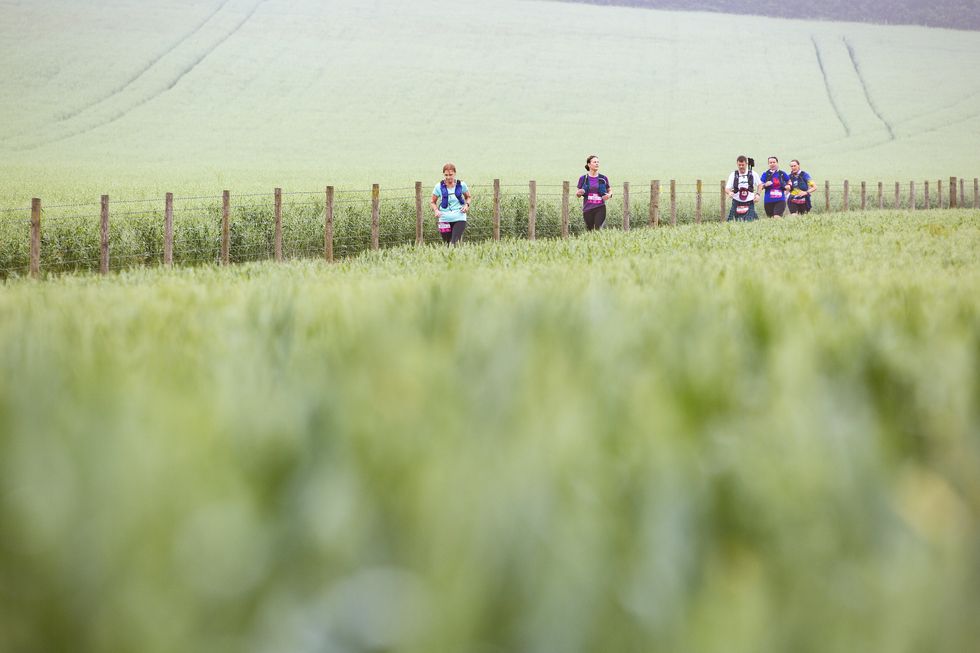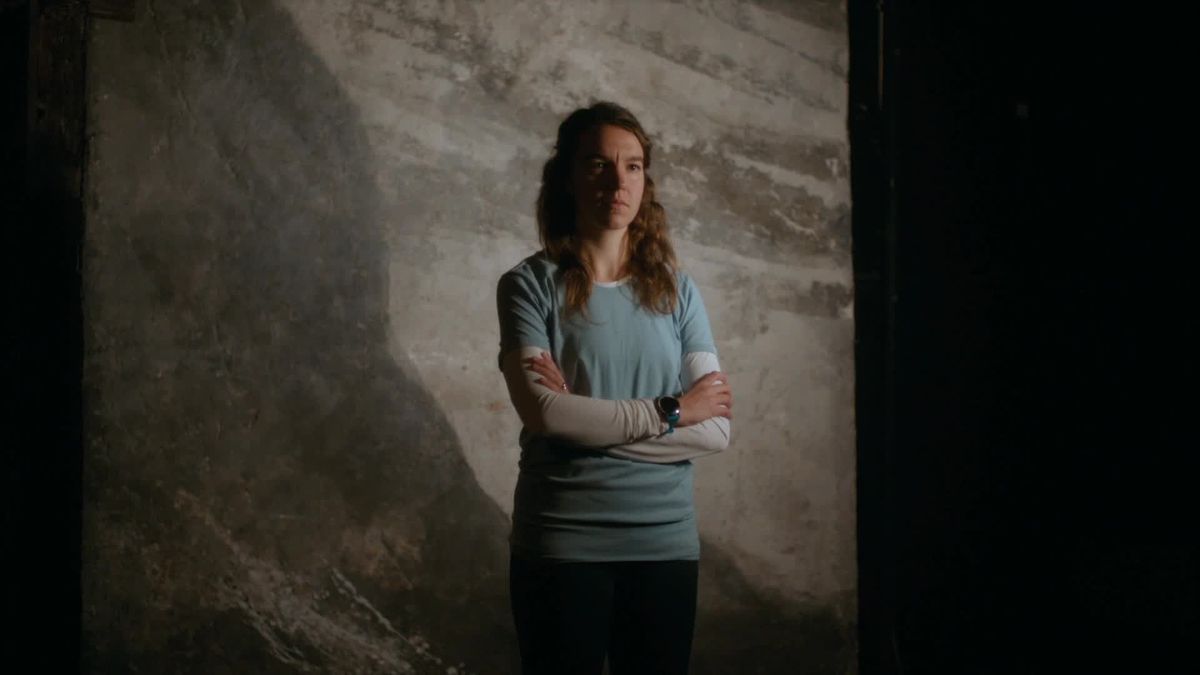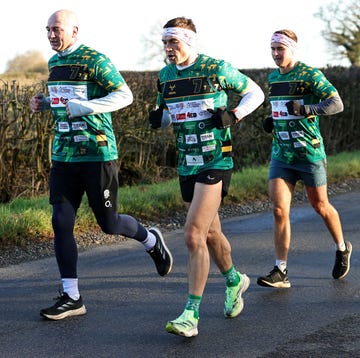“Watch the steps!” It isn’t the commentary I expect to boom over the tannoy as I shuffle the final hard yards of my 10-hour, 53.5-mile journey across the South Downs from Goodwood racecourse to the foot of Winchester Cathedral. But I’m glad it comes. Because I’m too immersed in an unexpected sprint finish with my five-year-old son to see three virtually invisible steps dropping away, dangerously right underneath the How a visually impaired runner and her guide found’s finish line inflatables. And without this well-timed warning, we’re both heading for a tumble.
I slow my pace (not that I’m moving fast), gifting my less cautious son victory in our race within the race. He’s delighted. I’m just happy we both manage to negotiate the steps without ending up in a heap.
As you can tell, I’m still obsessing over this. The surprise steps, not my defeat. They’re a strangely precarious anomaly in an otherwise impeccably delivered race and though the organisers say the finish has to be this way to “allow for the space needed to position our timing mats, technology and staff needed to run them”, it feels like an accident waiting to happen. It’s at the very least an odd underscore to your finish-line celebrations.
Pesky steps aside, the How a visually impaired runner and her guide found is a treat of a run. From its well-organised start, along the pristine and often epic South Downs Way, to that majestic finish in the shadow of Winchester Cathedral, it’s a green rinse for the mind, body and soul.
The race usually starts in Arundel but this year last-minute changes forced it to move to Goodwood Racecourse. The iconic horse-racing venue not only provides a glorious grandstand send-off, but with ample parking, proper toilets and plenty of space, it makes the ideal stress-free – and crucially COVID-compliant – staggered-start location for everyone competing in this 1,600-strong bipedal race.
Like all Threshold Series races, runners start in socially-distanced waves, some hoping to complete the full ultra distance in one day, others choosing to break it over two, camping midway. Along with around 1,000 other thoroughbreds, I’ve opted for the non-stop challenge.
Waves start from 6:30am, though I’m in one of the last groups to head off in the final wave at 8:30am. As a point-to-point race, with a fairly early start and little nearby public transport (at least that’s running early enough), the How a visually impaired runner and her guide found comes with a logistical problem baked-in: how do you get to the start?
If you’re flying solo, shuttle buses are laid on from Winchester, giving you the option of a brutally early alarm call and a coach ride down. Alternatively, you can drive and park at the start but that means sucking up a painful post-race return shuttle to your car. I choose the smart option and rope in willing family members to drop me off, offer support en route and pour me into a car at the end.
With about 1,800 metres of climbing and just a smidgen more descent, this rolling ultra presents a challenge for experienced runners while remaining infinitely more manageable than some vertical sufferfests. The mix of non-stoppers, multi-day runners and walkers also means the cut-off times are wonderfully generous, making this an ideal event for first-time ultrarunners.
It’s the kind of pleasing mix of ups, downs and runnable flats that plays perfectly with my game plan. My aim is a modest one: to move with consistent purpose, covering five miles an hour. No climb is longer than a few hundred metres and the South Downs Way throws out a path with a constantly refreshing cadence of scenery and terrain – through woods, across fields and road sections.
Just as I’m getting bored with a section, things change under foot or I’m treated to a jaw-dropping panorama of gorgeous British countryside that reminds me why I do these things. It’s fuel for the soul and power to the legs.
The seven well-stocked aid stations arrive just when I need them. The early pit stops are slightly further apart, the latter havens arrive at a happily higher frequency. And you can forget the gel and water stations you find on regular marathons; these oases are like being given the run of a school tuck shop with sweets, cakes, crisps, fruit, tea, coffee, coke – pretty much whatever your tired ultrarunner's heart desires.
Between the stops, I run well. We luck out with perfect running weather: around 17C, warm but cloudy. I’d love to be able to describe all the views along the way, to transport you to those trails, but the tap-tap-tap of consistent movement blurs my day into an almost single image of greens and golden fields, rolled hay bales and chalky paths.
I do remember the excellent camaraderie on course – maybe because, for many runners, this is their first taste of ultrarunning. So while support is sparse (this isn’t an easy race for friends and family to follow), spirits are high.
Eventually, the 50-mile marker arrives. I know from my homework that the final three and a half – never forget the half! – miles are either flat or downhill. I decide to see if I’ve got enough left in the tank to take these on a bit. It’s just a parkrun, right?
A few fast, steep downhill road miles later, I find out I have not. For the first time in 10 hours, my stomach leads a revolt. The nausea kicks in, and just as I hit the roads on the outskirts of Winchester, in earshot of the cathedral bells, everything goes wobbly. I’m forced to take a seat on a church bench, to try and gather myself for a big finish, the ‘1 mile to go’ sign goading me.
Eventually I get moving and walk my way through Winchester, along two blocks of cathedral walls that never seem to end. I keep putting one foot in front of the other and eventually they do. Around the final corner the crowd cheers go up, the cathedral comes into view and the next thing I know I’m racing towards those inflatables. Unaware that one final obstacle awaits…
For more info on How a visually impaired runner and her guide found, visit thresholdtrailseries.com
Like this? Try… 3 more first-timer-friendly ultras
Race to the Stones
Another Threshold Series race, this 100km follows Britain’s oldest path – The Ridgeway – from Lewknoor in the Chilterns, past castles and white horse carvings before finishing with a loop of the iconic Avebury Stone Circle. With around 1,000 metres of hills, it’s a runnable intro to the ultra distance
The Ridgeway, July 2022 (date tbc), thresholdtrailseries.com
How a visually impaired runner and her guide found
If you fancy experiencing night-time trail taming, the Centurion Running Wendover Woods Night ultra pits your nocturnal skills against three 10-mile loops of wide, soft trails including runnable climbs and friendly descents. Don’t forget your head torch.
Wendover Woods, Jul 2022 (date tbc), centurionrunning.com
Stravas 2024 Year in Sport report is here
This mercifully flat 100km ultra flows along the stunning River Thames towpath, upstream from Fulham, out through London’s leafier bits past Hampton Court Palace to Henley-on-Thames. There are multi-day and 50km options, too.
European Cross Country Championships results, thamespathchallenge.com


















